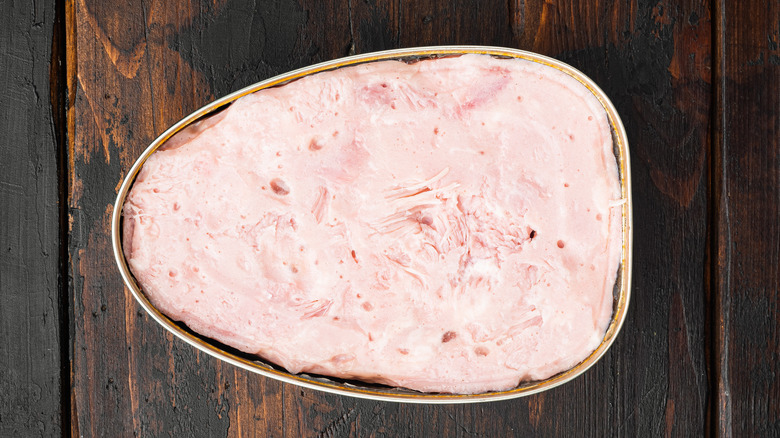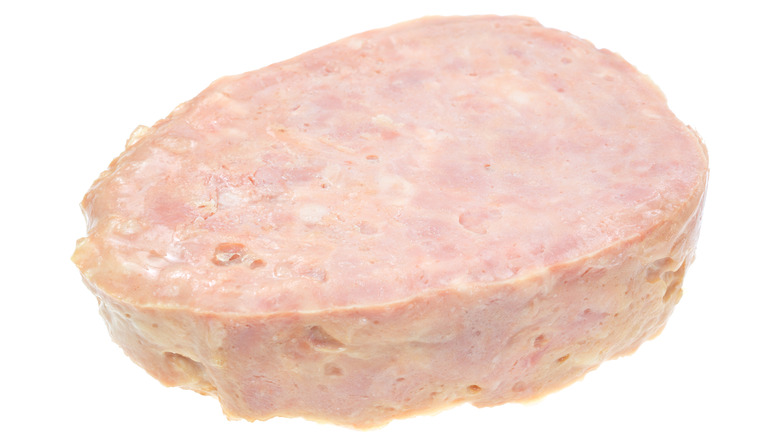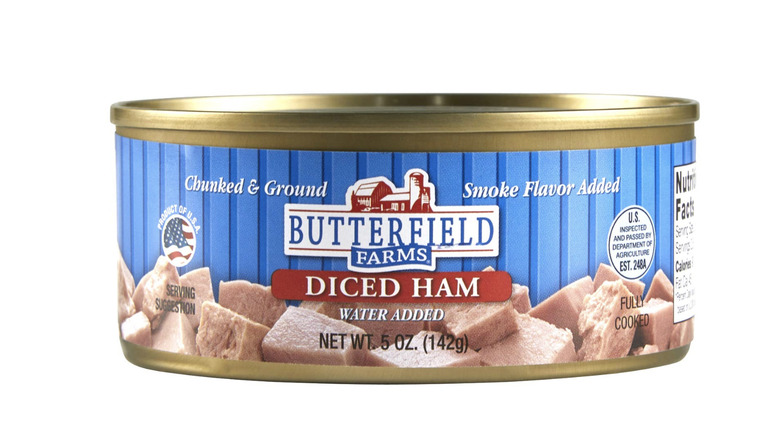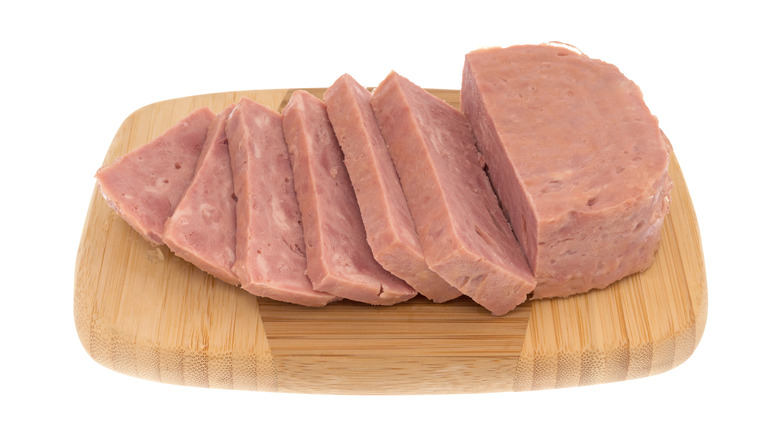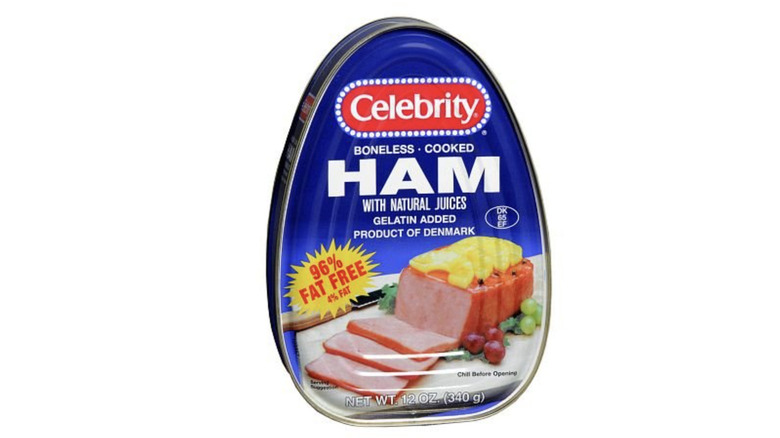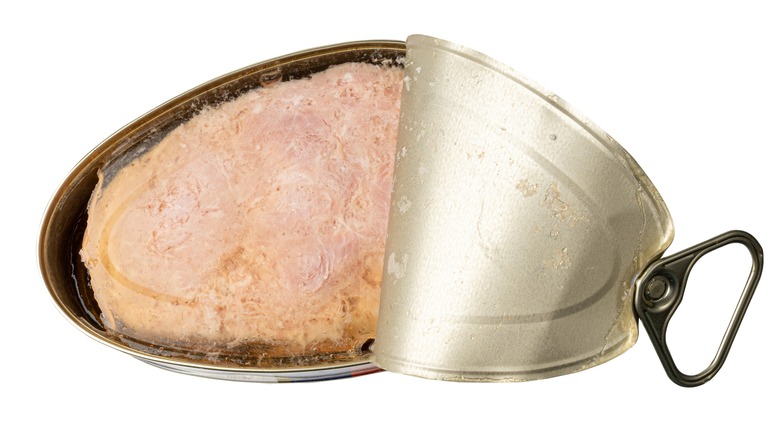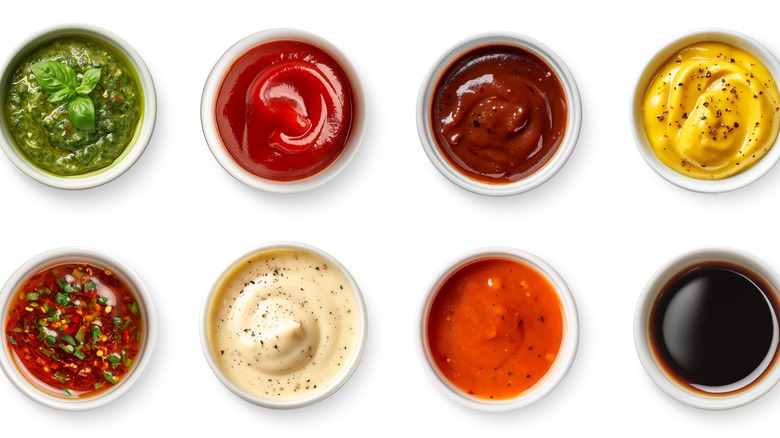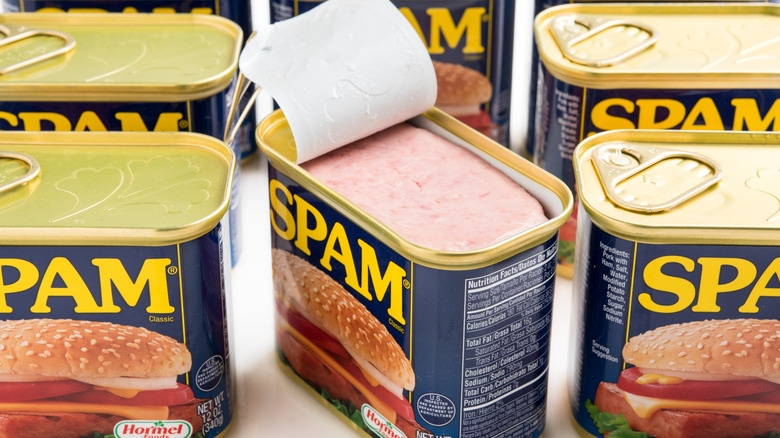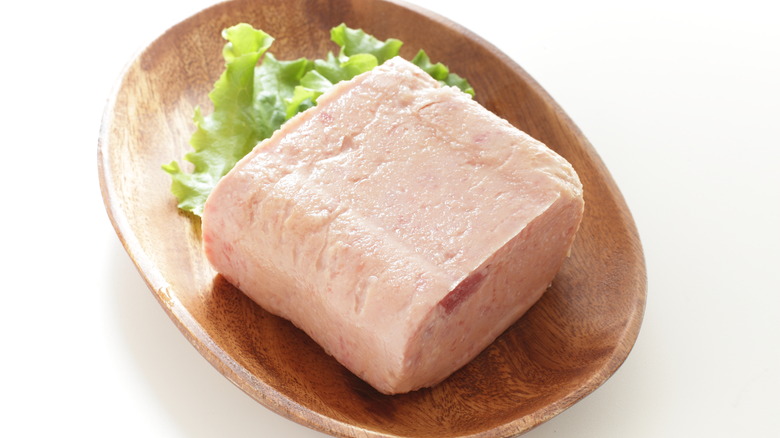10 Big Mistakes Everyone Makes With Canned Ham
We may receive a commission on purchases made from links.
Convenient and affordable, canned ham is one of those staples we love to hate. Ready to eat straight out of the can, the processed meat is a common go-to when we need a quick and versatile snack. Whether layered on a sandwich or tossed with eggs, canned ham is a practical choice, even though it may not be as glamorous as some other culinary ingredients.
Made from pork, canned ham is cured, vacuum-sealed in a tin, and cooked. The boneless meat is frequently packed in gelatin, which mixes with the meat's natural juices and cushions the product during handling. It's this preservation method that makes canned ham so shelf-stable. In fact, as long as it's unopened, the product can be kept in the pantry for years without spoiling, making it a convenient back up meal.
Although canned ham is a common pantry staple, many of us fail to make the most out of this versatile ingredient. Ready to find out how to take canned ham to the next level? Take a look at our list of the biggest mistakes everyone makes with canned ham — and how to avoid them!
1. Not removing gelatin from canned ham
When you first open a can of ham, it's impossible not to see the glossy gelatin that surrounds the meat and pools at the edges of the can. The jiggly substance typically ranges in color from pale yellow to amber. The gelatin is there to cushion the ham in the tin during handling and shipping, ensuring that the meat product retains its quality and shape.
The gelatinous layer in canned ham is produced with dry gelatin. More specifically, around a quarter of an ounce of the stuff is added to each can of ham before it's sealed. The ham is then cooked inside the can with steam, at which point the dry gelatin blends with the ham juices. As the ham cools, the can is vacuum-sealed and the gelatin sets.
Since the gelatin has a mildly salty flavor and a jelly-like texture, it's best to remove it before eating the ham — unless, of course, you enjoy the added flavor and texture. The best way to do this is to drain the can of any liquids and gently scrape off the jelly with a knife. Some people are so against the flavor and consistency of the gelatin that they even rinse the ham with water before eating it.
2. Thinking that all canned ham is created equal
There are two different types of canned ham. Most people are familiar with shelf stable canned ham, which can be stored in the pantry for up to five years. This type of ham is processed in a way that kills any bacteria that could grow at room temperature. That said, storing this kind of ham at a temperature above 122 degrees Fahrenheit can spoil the product. The second type of canned ham has to be refrigerated since it's not sterilized during the canning process. This kind of ham can be kept in the refrigerator for up to nine months.
Across these two types, there are some canned ham products that are better than others. Mashed reviewed different canned ham brands, crowning Hormel Smoked Ham as the top choice for its exceptional flavor. In fact, we enjoyed this ham so much that if served on a charcuterie board, we wouldn't be able to tell it was a canned product. Another canned ham that ranked high on the list is Butterfield Farms Diced Ham, which boasts a delightful smoked flavor. On the other end of the spectrum, Bristol Hickory Smoked Ham didn't fare so well, being both bland and spongy in texture. Another product that has been declared a miss is Iberia Boneless and Skinless Cooked Ham for its lack of flavor and strange smell.
3. Freezing ham in the can
While shelf-stable canned ham typically comes with a "best by" date on the packaging, as long as the tin hasn't been opened, there's no reason to freeze the meat. This is because canned ham can be eaten past its "use by date," as long as the tin isn't damaged in any way. Since the food is commercially sterile and sealed under vacuum, it won't begin to spoil until the can is opened. Nevertheless, it may deteriorate in quality over time. Notably, freezing ham in the can may damage the tin since food expands when frozen, leading to spoilage.
If you have opened a can of ham and won't be able to eat it within the next few days, it's best to freeze it for later use. Be sure to transfer the meat from the can to a freezer bag, plastic wrap, or freezer paper. The product should be tightly wrapped to keep it as moist as possible and marked with the freezing date. Ham can be frozen for one to two months. While freezing ham doesn't detract from its nutritional value, it's likely to affect its flavor and texture. As such, it's best to freeze it at its freshest.
4. Storing canned ham improperly after opening and keeping it too long
While shelf stable canned ham can be stored at room temperature for between two and five years, this storage time is drastically reduced as soon as the can is opened. Furthermore, once opened, canned ham must be kept in the refrigerator. If stored properly at below 40 degrees Fahrenheit or lower, refrigerated ham should remain safe to eat for three to four days. Meanwhile, unopened canned ham with a "keep refrigerated" label shouldn't be kept in the refrigerator for longer than six to nine months. No matter the ham type, if the tin happens to be dented or rusted, throw it away since there's a risk that it has been contaminated with bacteria.
Storing an opened can of ham — or other types of canned meat — in the refrigerator is a huge no-no. This is because the tin and iron from an opened can may leach into the food, affecting its flavor and potentially causing illness. Instead, it's best to transfer the ham to a plastic or glass storage container. This won't just ensure that the ham is safe to eat, but also preserve its flavor and quality. In addition, never let canned ham that has been removed from the packaging sit outside the refrigerator for longer than two hours.
5. Thinking that canned ham needs to be cooked and cooking it at the wrong temperature
Since canned ham with a "fully cooked" label on the packaging is already pre-cooked, it can be eaten straight out of the can without any further preparation. In fact, this is precisely what makes canned ham such a convenient snack. In addition, before refrigeration became widely available, this shelf stability allowed people to store meat for prolonged periods of time.
If you'd like to heat up canned ham, remove it from the tin, set the oven to at least 325 degrees Fahrenheit, and cook the meat until it reaches an internal temperature of 140 degrees Fahrenheit. If the canned ham hasn't been pre-cooked, make sure that it reaches an internal temperature of 165 degrees Fahrenheit. For optimal results, remove the ham from the oven when its internal temperature is 5 degrees Fahrenheit below the target and let it rest for about 15 minutes. During this resting period the ham will continue to cook, reaching the desired temperature.
Just as it's important not to undercook the ham, as this could make it unsafe to eat, it's also crucial not to overcook it as this can dry it out. To ensure accuracy, it's best to check the meat for doneness using a quality food thermometer. Also, never heat up canned ham in the tin — regardless of whether it has been opened or not.
6. Only using canned ham for sandwiches
While canned ham shines in sandwiches, the versatile meat can be used in a huge variety of dishes. Perhaps the easiest way to prepare canned ham is by slicing it and frying it in a skillet like bacon. This will give it a slightly crispy exterior, making it a perfect addition to morning eggs and toast. Alternatively, you can chop the meat into cubes and add it to hearty casseroles, hashes, and soups.
While canned ham has a slightly different flavor and texture than the fresh ham you can buy at your local deli counter, it can be used as a replacement in most recipes. Canned ham can even be glazed and baked, if you want to go in that direction. To make baked ham, all you need for the glaze is stone-ground mustard, honey, ground cloves, chopped parsley, and a little salt to taste. Another ham-based dish that requires few ingredients is deviled ham salad. To make it, simply blend chopped up canned ham, celery, yellow onion, and dill pickles in a food processor. Next, combine the mixture with mayonnaise, salt, and pepper. Deviled ham salad tastes best spread over toast or as a dip on crackers.
7. Not experimenting with condiments
Being mild and slightly salty, canned ham can benefit from an additional depth of flavor. Condiments can also provide a welcome contrast to the dense texture of the processed meat. If you're baking canned ham in the oven, coat it in a glaze made with honey, brown sugar, and spices. Alternatively, replace the honey with pineapple juice. The glaze will caramelize in the oven, imbuing the ham with a sweet and tangy flavor. One Quora user shares their recipe for baked ham, saying: "Cut the basic diamond pattern into a ham. [...] Brush on about 3/4 [cup of the glaze]. Then loosely cover with foil and bake. Every 20 minutes I baste the ham with the glaze and the drippings from the bottom of the pan."
Any canned ham dish can also be served with sauces on the side, allowing diners to customize their dish. One of the best ways to add a little zing to canned ham is by pairing it with a honey mustard sauce. Despite its name, the sauce doesn't always require mustard, with one recipe calling for honey, mayonnaise, Worcestershire sauce, garlic powder, paprika, and a little salt. To complete the picture, top canned ham with fresh herbs like thyme or parsley.
8. Confusing canned ham with SPAM
While Spam and canned ham are both pork pantry staples that come in a tin, they shouldn't be confused as the same product. Traditionally packed in pear-shaped cans, canned ham is made from several pieces of ham compressed into a solid chunk of meat. The bigger the can, the higher the chance that it contains a single piece of ham. In contrast, Spam is made from ground ham and pork, which are then pressed together inside a can.
According to the Hormel Foods website, the company produced the first canned ham in 1926. The "flavor-sealed ham" was advertised as retaining "all those natural flavors and savory juices, which escape in water and steam by the usual cooking methods" (via Hormel Foods). Spam, on the other hand, was unveiled in 1937 and named after the combination of the first two letters of the word spice and the last two letters of the word ham. In case you're wondering, spam doesn't contain any spices. Spam came into the spotlight during World War II when 100 million pounds of the jelly-laden meat were sent to the frontlines to feed troops.
9. Not cooking canned ham in an air fryer or a slow cooker
While ham is traditionally baked in the oven, it can also be prepared in an air fryer or a crock pot. Just like fresh ham, canned ham adapts well to these alternative cooking methods. An air fryer cooks by circulating hot air around the food, giving it a crispy exterior without the need for excess oil. As such, this cooking method can give canned ham a crispy outer while keeping it moist on the inside. Vanessa Gabel shared her recipe for air fried canned ham with The Daily Item, saying that while the cooking method worked well, it made the ham quite soft. "To accommodate for this, we did the final cook at 400 degrees. That crisped it up on the outside and made the texture more appealing to our family," she said.
Just like its name suggests, a slow cooker cooks food over several hours on low heat. This lets the flavors of the food meld together, resulting in a juicy and flavorful dish. To make the most out of this cooking method, coat the meat in a mixture of honey, brown sugar, Dijon mustard, ground cloves, and ground cinnamon. Once in the crock pot, carefully pour pineapple juice around the edges of the ham to ensure that it doesn't wash off the glaze. Cook the ham for between four and six hours, basting it occasionally in the juices from the bottom of the slow cooker.
10. Thinking that canned ham is always bad for you
While canned ham may not be as nutritious as fruits and vegetables, it isn't quite as unhealthy as you might think. This might be because the processed protein is made with simple ingredients, including ham, salt, sugar, water, and preservatives. On the positive side, canned ham is a decent source of protein, with 9 grams of the essential nutrient in each 56-gram serving of the processed meat. It also contains no sugar and is low in calories and fat.
When eaten in moderation and combined with nutrient-rich side dishes like vegetables or whole grains, canned ham can be a part of a balanced diet. However, moderation is the operative word here. The biggest problem with canned ham is its high sodium content. Specifically, a serving of canned ham contains 620 milligrams of sodium, or 27% of the recommended daily allowance. Consuming too much sodium can raise blood pressure and contribute to heart problems.
